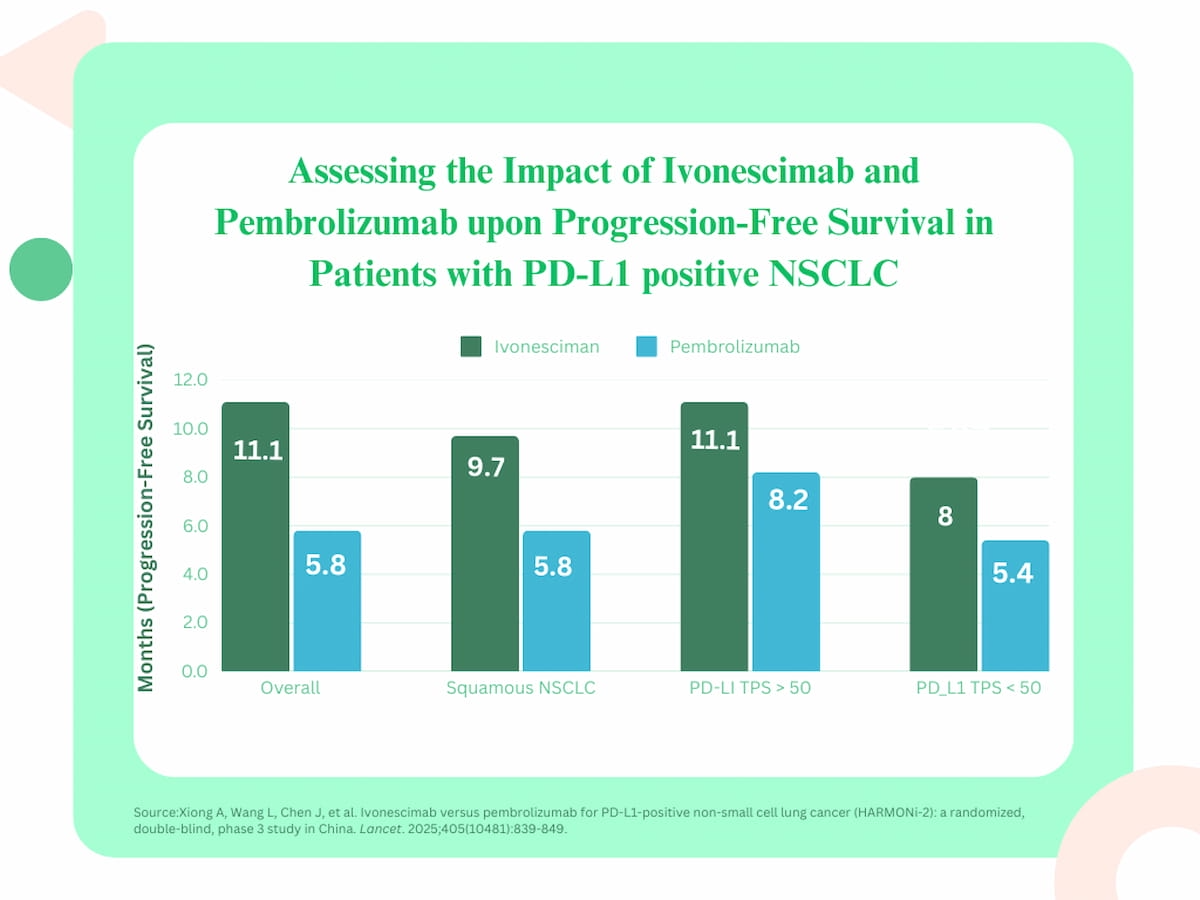For patients with programmed cell death ligand-1 (PD-L1)-positive non-small cell lung cancer (NSCLC), the emerging bispecific antibody ivonescimab may provide significantly longer progression-free survival (PFS) in comparison to pembrolizumab, according to imaging findings from a phase 3 randomized multicenter study.
For an interim analysis from the ongoing HARMONi-2 study, recently published in the Lancet, researchers reviewed computed tomography (CT) and magnetic resonance imaging (MRI) data from 198 patients treated with ivonescimab, which targets PD-1 and vascular endothelial growth factor (VEGF), and 200 patients treated with pembrolizumab (Keytruda, Merck), an FDA-approved therapy for advanced NSCLC and PD-L1 tumor proportion score (TPS) of at least 1 percent.
A blinded independent radiology review committee (IRRC) assessed tumor progression on CT or MRI every six weeks for the first 48 weeks and every 12 weeks afterward until the occurrence of disease progression, study discontinuation, patient withdrawal from the study or patient death, according to the study.
The researchers found an overall stratified hazard ratio (HR) of 51 percent associated with ivonescimab, which offered a mean PFS of 11.1 months in contrast to 5.8 months for patients in the pembrolizumab group.
“Compared with pembrolizumab, ivonescimab reduced the risk of disease progression or death by 49%, with an associated improvement in median PFS of 5.3 months. To our knowledge, this is the first time that a novel treatment has provided a significant improvement in PFS in a randomized phase 3 trial over immune checkpoint inhibitor-based monotherapy,” wrote lead study author Anwen Xiong, Ph.D., who is affiliated with the Shanghai Pulmonary Hospital and the Tongji University School of Medicine in Shanghai, China, and colleagues.
Subgroup analysis also revealed favorable PFS benefit for the use of ivonescimab. Pointing out that squamous NSCLC occurs in 25 to 30 percent of NSCLC cases, the researchers found that ivonescimab was associated with a median PFS of 9.7 months vs. 5.8 months for pembrolizumab.
While the agent bevacizumab is contraindicated in this patient population due to high risk for life-threatening or fatal bleeding complications, the study authors said ivonescimab showed “no evidence” of these complications in the study and has a similar safety profile to pembrolizumab for patients with squamous NSCLC.
Three Key Takeaways
1. Ivonescimab significantly improves PFS. In a phase 3 trial, ivonescimab demonstrated a 49 percent reduction in disease progression or death compared to pembrolizumab with a median progression-free survival (PFS) of 11.1 months vs. 5.8 months.
2. Potential alternative for PD-L1-positive NSCLC. Ivonescimab showed consistent PFS benefits across PD-L1 subgroups, including those with low-to-intermediate PD-L1 expression (TPS 1-49 percent), suggesting it could be an alternative for patients who are ineligible for or unwilling to undergo chemotherapy.
3. Favorable safety profile. Unlike bevacizumab, which poses a high risk of fatal bleeding in patients with squamous NSCLC, ivonescimab did not show such complications and had a safety profile comparable to pembrolizumab.
For patients with at least a 50 percent PD-L1 TPS, ivonescimab led to a 11.1-month median PFS in contrast to 8.2 months for pembrolizumab, according to the study authors. The researchers noted that ivonescimab was also associated with significant median PFS benefit in patients with a PD-L1 TPS below 50 percent in comparison to pembrolizumab (8 months vs. 5.4 months).
“Although anti-PD-1 plus chemotherapy is generally (favored) for patients with low-to-intermediate PD-L1 expression (TPS 1–49%), at least outside of China, these findings suggest that ivonescimab monotherapy could provide an alternative treatment for these patients who are poor candidates for or disinclined towards chemotherapy,” posited Xiong and colleagues.
(Editor’s note: For related content, see “Key Chest CT Parameters for Body Composition May be Prognostic for Patients with Resectable NSCLC,” “Computed Tomography Study Assesses Model for Predicting Recurrence of Non-Small Cell Lung Cancer” and “What Emerging CT Research Reveals About Obesity and Post-Op Survival for Non-Small Cell Lung Cancer.”)
In regard to study limitations, the authors conceded that PFS improvement for ivonescimab may not correlate with overall survival, noting that overall survival rates for the cohort were not available at the present time. The researchers noted that the cohort was entirely comprised of Chinese patients, which may limit extrapolation of the study findings to broader populations.
